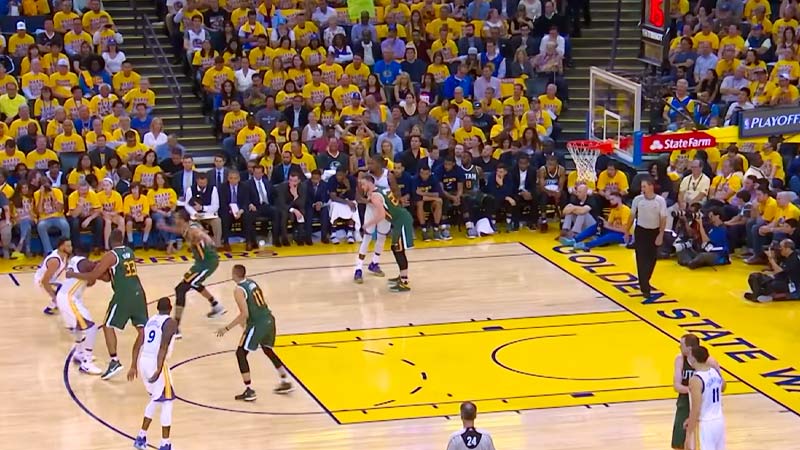Transition is a term that refers to the phase of the game when the teams switch from offense to defense or vice versa.
It is one of the most important aspects of basketball, as it can create scoring opportunities or prevent them.
Transition can be either offensive or defensive, depending on whether the team has possession of the ball or not.
In this blog post, we will answer some of the most frequently asked questions about transition in basketball and provide some tips on how to improve your transition skills.
What Is Transition in Basketball and Why Is It Important?
Transition in basketball refers to the rapid change of possession from defense to offense or offense to defense.
It occurs when a team quickly moves the ball up the court to exploit scoring opportunities before the opposing team can set up their defense. Transition play is a crucial aspect of basketball as it allows teams to gain an advantage, create fast-break opportunities, and score easy baskets.
During a transition, the team in possession of the ball aims to exploit the momentary advantage of having more offensive players near the basket than defenders.
This advantage can be gained by pushing the ball up the court quickly, using quick passes to find open teammates, and attacking the basket before the defense is set.
Transition offense often leads to higher percentage shots such as layups, dunks, or open three-pointers, increasing the chances of scoring efficiently. On the defensive side, transition defense focuses on slowing down the opposing team’s fast break and preventing easy scoring opportunities.
What Does Scoring in Transition Mean in Basketball?
One of the most effective ways to score in basketball is to score in transition. This means that a team tries to score a basket as soon as they get the ball before the other team can set up their defense.
There are two main ways to score in transition: fast break and advantage break. A fast break is when a team uses speed and teamwork to move the ball up the court and create an open shot.
A fast break usually involves two or more players who pass the ball quickly and accurately and one or more players who finish the play with a layup, dunk, or jump shot. A fast break can be triggered by a steal, a rebound, or an outlet pass.
An advantage break is when a team has more players on offense than the defense has on defense, such as in a 3-on-2 or 2-on-1 situation.
What Is Offensive Transition in Basketball?

Source: basketballsocietyonline.com
Offensive transition is the phase of the game when a team gains possession of the ball and tries to score as quickly as possible.
Offensive transition can be triggered by various events, such as a steal, a rebound, a turnover, a blocked shot, or a missed shot by the other team. The goal of the offensive transition is to catch the defense off guard and create scoring opportunities before they can recover.
To execute an effective offensive transition, a team needs to have good ball handling, passing, spacing, and decision-making skills.
Basics of Offensive Transition
The basic principles of offensive transition are:
- The player who gets the ball should look to push the pace and advance the ball up the court as fast as possible, either by dribbling or passing.
- The other players should run ahead of the ball and fill the lanes on both sides of the court, creating width and depth for the offense.
- The player with the ball should look for an open teammate who has a clear path to the basket or an open shot, and pass the ball to them.
- If no open teammate is available, the player with the ball should look to attack the basket themselves, either by driving or shooting.
- If the defense manages to stop the initial attack, the offense should transition into their half-court offense and run a set play.
What Is Defensive Transition in Basketball?

Source: michigandaily.com
Defensive transition is the phase of the game when a team loses possession of the ball and tries to prevent the other team from scoring in transition.
Defensive transition can be triggered by various events, such as a made basket, a turnover, a rebound, or a steal by the other team.
The goal of defensive transition is to slow down or stop the offense from scoring easy points, and force them to play against a set defense.
To execute an effective defensive transition, a team needs to have good communication, hustle, awareness, and positioning skills.
Basics of Defensive Transition
The basic principles of defensive transition are:
- The player who is closest to the ball should try to stop or delay the ball handler from advancing the ball up the court, either by applying pressure or by getting in front of them.
- The other players should sprint back to their own basket and form a defensive wall that protects the paint and denies any easy layups or dunks.
- The players should match up with their assigned opponents or switch if necessary, and cover any open shooters or cutters on the perimeter.
- If the offense manages to break through the defense and get a shot off, the defense should contest the shot without fouling and secure the rebound.
Significance of Transition in Basketball
Transition is one of the most important aspects of basketball, as it can have a huge impact on the outcome of a game. Transition can affect various factors, such as:
Tempo
Transition can determine how fast or slow a game is played. A team that excels at transition can dictate the pace of the game and force their opponents to play at their preferred speed.
Efficiency
Transition can affect how efficiently a team scores or defends. A team that scores in transition can increase their points per possession and shooting percentage, while a team that defends in transition can lower their opponents’ points per possession and shooting percentage.
Energy
Transition can influence how much energy a team has throughout a game.
A team that scores in transition can boost their confidence and enthusiasm, while a team that defends in transition can drain their opponents’ morale and stamina.
FAQs
How do you practice transition in basketball?
One way to practice transition in basketball is to run drills that simulate different scenarios involving transition.
For example, you can run 3-on-2 or 2-on-1 drills that focus on offensive or defensive transition skills. You can also play full-court games that emphasize transition and reward fast breaks or stops.
What are some examples of teams that are good at transition in basketball?
Some examples of teams that are good at transition in basketball are the Golden State Warriors, the Milwaukee Bucks, the Phoenix Suns in the NBA, the Gonzaga Bulldogs, the Baylor Bears, and the UCLA Bruins in the NCAA.
What are the benefits of playing fast in transition?
Playing fast in transition can give you an advantage over your opponents, as you can catch them off guard and exploit their defensive weaknesses.
By playing fast, you can create more possessions, more shots, and more points. You can also tire out your opponents and force them to make mistakes.
What are the keys to playing good transition defense?
Playing good transition defense requires communication, awareness, and effort. You need to communicate with your teammates to assign roles and responsibilities, such as who is stopping the ball, who is matching up with the shooters, and who is protecting the basket.
You need to be aware of where the ball and your opponents are at all times and anticipate their moves. You need to put in maximum effort to sprint back, get in position, and contest every shot.
How can I improve my transition offense skills?
To improve your transition offense skills, you need to practice running the floor, passing the ball, and finishing at the rim. You need to run the floor with speed and purpose, looking for open lanes and teammates.
You need to pass the ball quickly and accurately, avoiding turnovers and finding the best shot. You need to finish at the rim with strength and finesse, using different moves and angles.
Bottom Line
Transition is a vital part of basketball that can make or break a game. Transition can be offensive or defensive, depending on whether you have the ball or not.
To be successful at transition, you need to have good skills, strategies, and habits that allow you to score or defend quickly and effectively.
Transition can affect various aspects of the game, such as tempo, efficiency, energy, and ultimately, winning. By mastering transition, you can take your game to the next level and become a more complete player. Best of luck.







